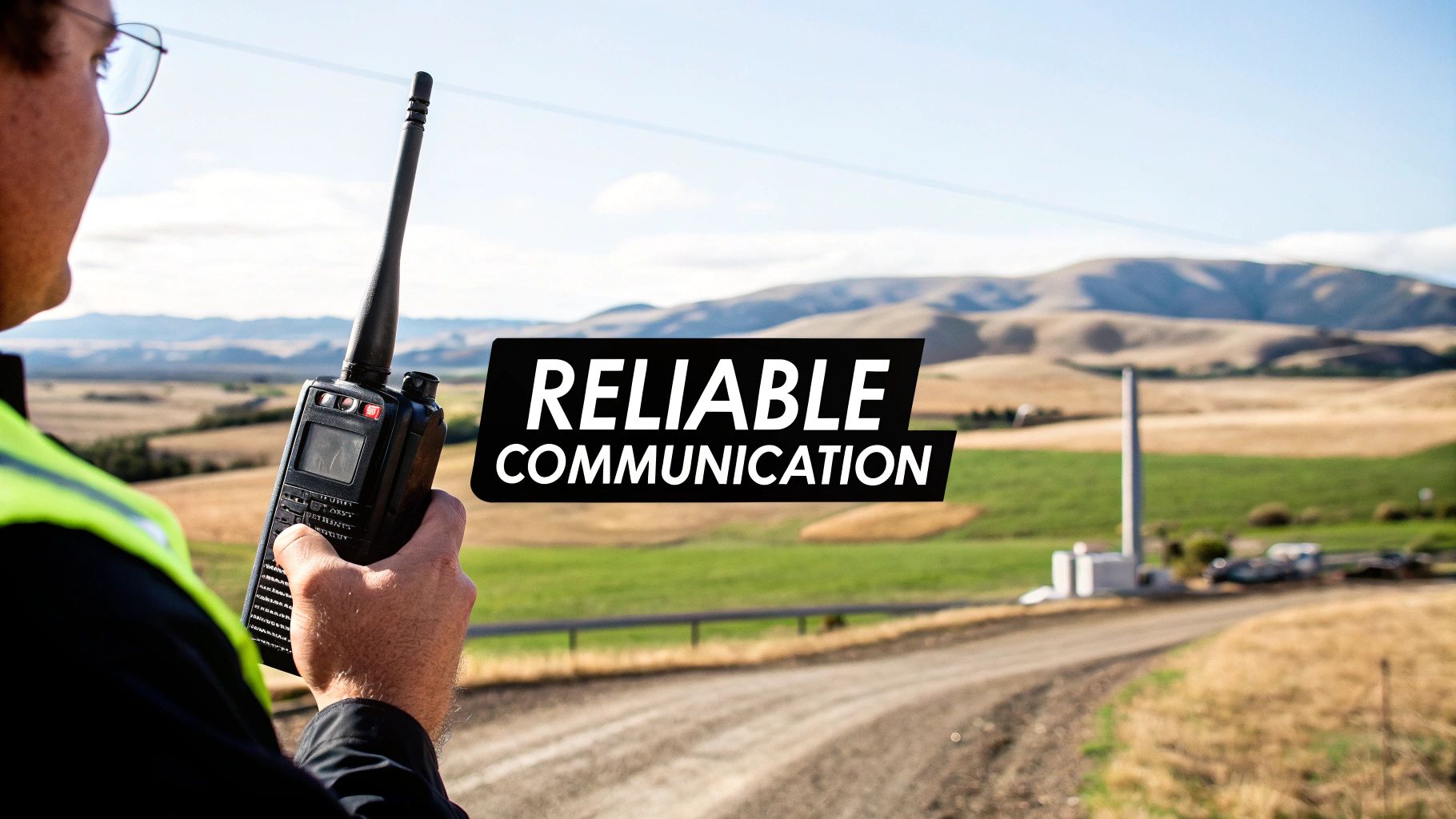Your Guide to Hytera Radios in New Zealand
When your team's communication absolutely cannot fail, what's the go-to solution? For countless businesses across New Zealand, the answer is Hytera radios. They’ve built a solid reputation as a leader in professional communication solutions, known for their rugged durability, crystal-clear digital audio, and legal compliance with New Zealand's radio spectrum regulations.
Why New Zealand Businesses Trust Hytera Radios
In a country shaped by rugged landscapes and demanding industries, reliable communication isn't just a nice-to-have—it’s the backbone of the operation. From the bustling construction sites of Auckland to remote agricultural operations in Canterbury, teams need a legal and effective communication tool that just works, every single time. This is exactly where Hytera has carved out its name.
Hytera’s strength lies in its diverse range of legally compliant communication devices. They offer everything from simple, licence-free handhelds perfect for coordinating staff at a local event, all the way up to sophisticated digital radio systems designed for nationwide logistics and transport operations. This versatility means that whether you're a small local business or a large enterprise, there’s a Hytera solution that fits your specific needs and is readily available in New Zealand.
Built for New Zealand's Demanding Conditions
Let's face it, New Zealand's work environments can be tough. A radio might get drenched in heavy rain on a West Coast building site, covered in fine dust in a Bay of Plenty packhouse, or blasted with the salty spray of the Tasman Sea. Hytera radios are engineered to handle these exact challenges.
Many models commonly available in New Zealand come with high IP (Ingress Protection) ratings, which certify their resistance to both dust and water. This intense focus on durability translates to less downtime from equipment failure and a much better return on your investment over the life of the radio.
For businesses in forestry, construction, or maritime sectors, this kind of ruggedness is non-negotiable. It’s what keeps the primary line of communication open, protecting both staff safety and operational efficiency, no matter what the weather throws at you.
Enhancing Team Coordination and Safety
Beyond simple push-to-talk, Hytera radios are packed with features that solve real-world problems. Crystal-clear digital audio with built-in noise cancellation technology ensures that crucial instructions are heard perfectly, even over the roar of heavy machinery. That clarity alone can prevent costly mistakes and dramatically improve on-site safety.
Even more importantly, Hytera radios are a powerful part of any guide to improving workplace communication. For teams spread across vast areas, GPS tracking provides real-time location data, which is a game-changer for managing fleets and speeding up response times in an emergency. For those working alone in isolated spots, features like "Man Down" and "Lone Worker" alerts act as an automated safety net.
This technology isn't just a convenience; it's a fundamental piece of a modern, effective health and safety strategy for any Kiwi business using legal communication devices.
Understanding Radio Tech and NZ Legal Rules
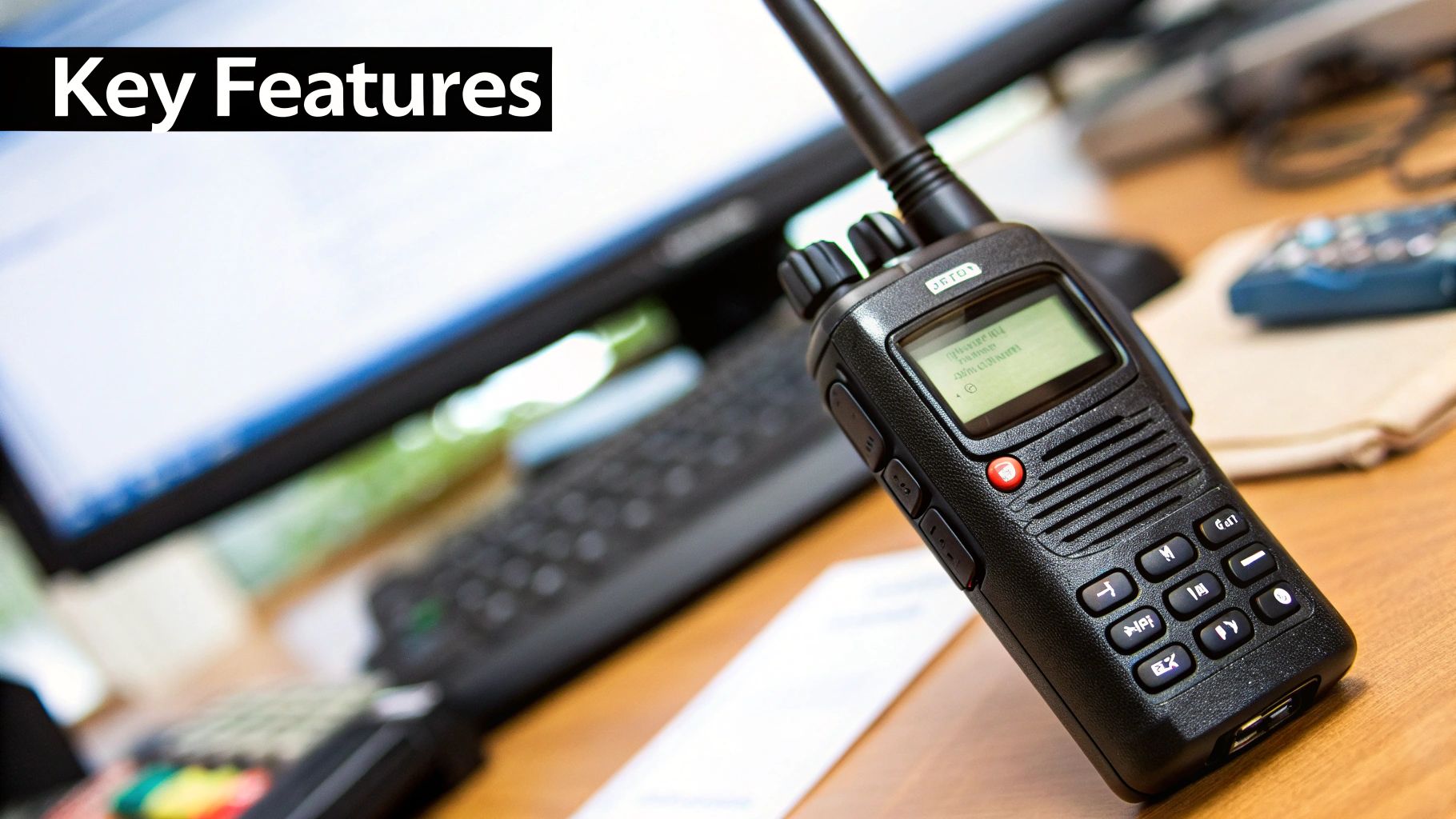
Before you select a radio, it’s crucial to understand the technology that makes it work and the legal requirements for using it in New Zealand. Getting this right from the start ensures your communications will be clear, secure, and fully compliant with local regulations. The most significant choice you'll face is between traditional analogue and modern digital radio systems.
Think of the jump from analogue to digital radio like upgrading from an old standard-definition TV to a crisp High Definition (HD) one. Analogue signals, which are continuous waves, have been the standard for decades. They’re reliable, but also susceptible to background noise and interference. As the user moves further away, the audio quality slowly degrades into static.
Digital radio, specifically Digital Mobile Radio (DMR), revolutionises communication. It converts your voice into a clean digital signal—a stream of 1s and 0s. This data packet is then transmitted and perfectly reassembled by the receiving radio. The result? Consistently clear audio right to the very edge of the radio's range. There’s no slow fade into static, just crystal-clear sound until the signal drops off completely. This difference is vital on a noisy construction site or during a windy day on the farm.
Analogue vs Digital: A Clear Breakdown
To put it plainly, digital technology brings a whole suite of advantages that solve many of the headaches inherent in analogue systems.
- Audio Quality: Digital radios use smart software to filter out background noise, so only the speaker’s voice gets through. This is massive for ensuring instructions are heard correctly the first time.
- Coverage: A digital signal maintains its audio quality across a much larger slice of the coverage area. While an analogue radio gets progressively fuzzier at a distance, a digital radio stays perfectly clear until it's out of range.
- Security: Anyone with a basic scanner can listen in on analogue chatter. Digital communication, however, can be encrypted. This makes it incredibly secure and perfect for security teams, private event staff, or any business discussing sensitive information.
- Features: The digital format isn't just for voice. It opens the door to features like text messaging, GPS location tracking, and advanced safety functions like 'Man Down' alerts—things that are simply impossible with analogue.
The great news is you don’t have to throw out your old gear overnight. Many Hytera radios available in New Zealand can operate in a "hybrid" or "mixed mode," letting them communicate with both your existing analogue radios and new digital ones. This provides a practical, budget-friendly pathway to upgrade your entire communications system over time.
Navigating New Zealand's Radio Licensing
Understanding the rules of the airwaves is just as important as the tech inside the radio. In New Zealand, the radio spectrum is managed by Radio Spectrum Management (RSM), a part of the Ministry of Business, Innovation and Employment (MBIE). Operating a radio without the correct authorisation is illegal and can lead to significant fines.
There are two main ways to legally use a two-way radio in NZ, and your choice of Hytera radios will depend on which path fits your needs.
1. General User Radio Licence (GURL) The GURL covers specific, public radio frequencies that anyone can use without needing their own licence, as long as their equipment meets certain technical standards. This is the common choice for lower-power, short-range communications.
- PRS (Public Radio Service): These are UHF frequencies often used for recreational activities or personal use.
- CB (Citizen Band): These are HF frequencies popular with truck drivers and 4WD clubs.
Hytera models designed for GURL frequencies are typically simpler and more affordable, making them an excellent fit for small retail shops, cafes, or coordinating local events. The main drawback is that these channels are public, can become congested, and offer no privacy.
2. Licensed Private Frequencies For most professional and commercial operations, a dedicated, licensed frequency is the only viable solution. This involves applying to RSM for your own private channel (or channels) in a specific geographical area.
This route provides you with exclusive access to your frequency, guaranteeing clear, interference-free communication for your team. It’s absolutely essential for businesses where reliability and security are paramount, such as in construction, transport, forestry, and large-scale agriculture. Professional-grade Hytera radios are specifically built for these licensed bands, delivering the power and performance required for serious commercial work.
If you want to dive deeper into these concepts, feel free to check out our detailed guide on radio communication basics.
Finding the Right Hytera Radio Model for You
Trying to pick the right two-way radio can feel overwhelming, especially with the various models and features available. But the process can be straightforward. The key is to match the radio's capabilities directly to your daily operational needs.
Are you coordinating a small team in a cafe? Or are you managing a massive fleet of trucks across the country? Your answer will point you to the right equipment. Let's break down the most popular Hytera radios commonly available in New Zealand into practical categories, so you can confidently select a tool that solves your real-world communication problems.
Simple and Licence-Free Solutions
For many businesses, communication needs are immediate and localised. Think of a bustling cafe syncing front-of-house with the kitchen, a retail team managing stock, or event staff guiding guests. In these scenarios, you don't need nationwide coverage; you need a reliable device that works straight out of the box.
This is where Hytera's licence-free radios excel. These models operate on the General User Radio Licence (GURL) public frequencies, meaning you don't need a private licence from Radio Spectrum Management (RSM). They are designed for ease of use, are generally more affordable, and provide a fantastic entry into professional communications.
- Hytera Power446: A classic example of a tough, no-fuss, licence-free radio commonly found in NZ. It’s compact, durable, and simple to use, making it ideal for hospitality, small construction sites, and schools.
- Key Benefit: These devices are essentially "plug-and-play." You can purchase a set and begin using them legally on the same day, without complex programming or licensing paperwork.
Remember, these public channels can be used by others nearby, so they are not suitable for sensitive or confidential conversations.
Professional DMR Handhelds
When your work becomes more demanding and your communications are mission-critical, it's time to step up to professional-grade Digital Mobile Radio (DMR) handhelds. These are the workhorses for industries like construction, manufacturing, forestry, and large-scale event management in New Zealand. They operate on private, licensed frequencies, guaranteeing your communications are secure, clear, and free from external interference.
This category includes some of Hytera's most popular and resilient models, such as the advanced HP series. These radios are built to withstand tough New Zealand conditions, often featuring high IP ratings for superior water and dust protection. For instance, an IP67 rating means the radio is completely sealed against dust and can survive submersion in one metre of water for 30 minutes.
This image shows how Hytera's portable radio lineup progresses from simple, entry-level gear to high-end, professional models.
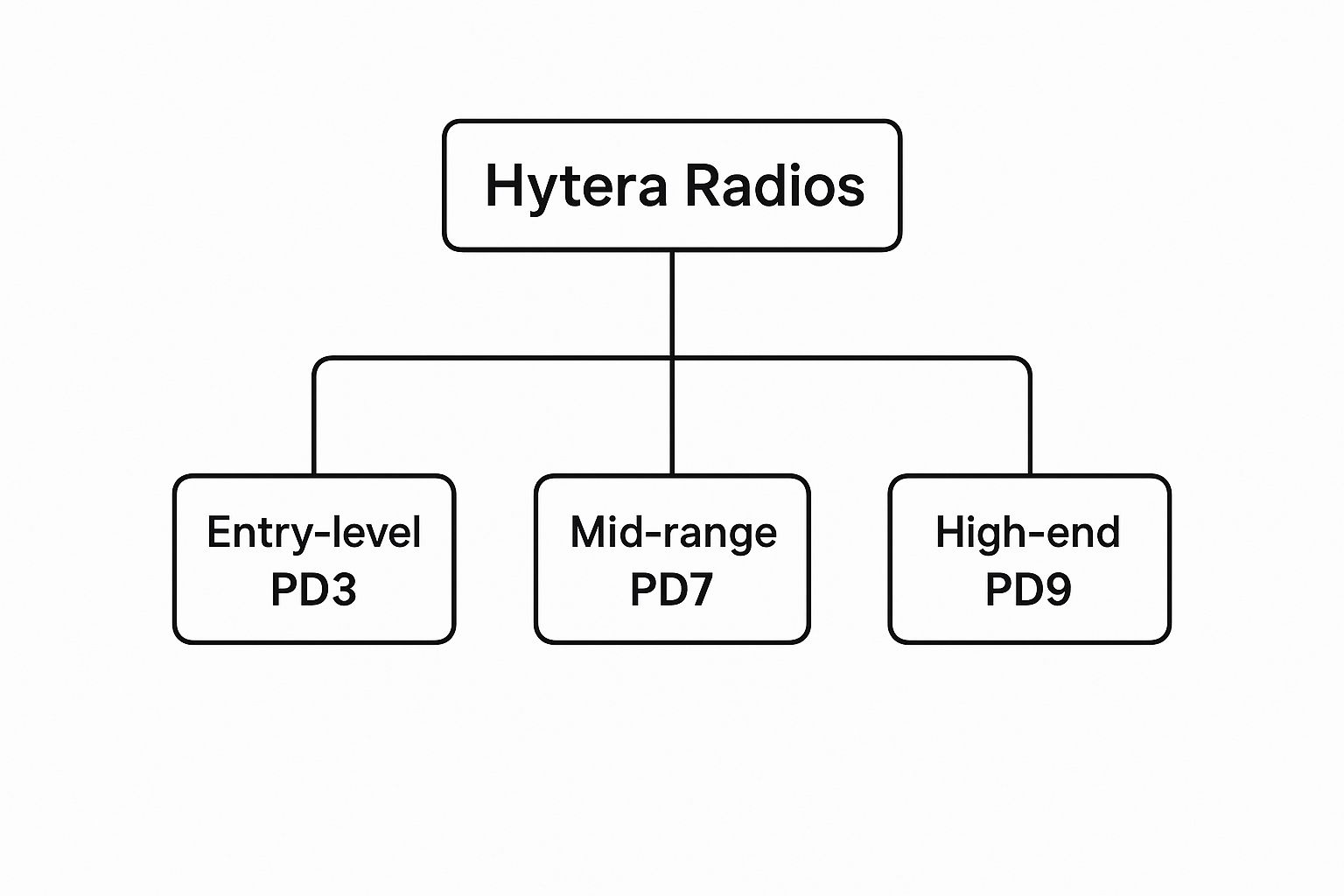
It’s a great visual guide that helps clarify how the different tiers are built to meet increasingly demanding professional needs. For a deeper look, check out our complete guide to the Hytera DMR product lineup and its introduction.
So, what does this mean for you? A professional DMR handheld like a Hytera HP602 or HP702 gives you more than just toughness. You get far superior audio quality thanks to AI-based noise cancellation, longer battery life for those full-day shifts, and much better security with digital encryption.
Hytera Radio Series Comparison for NZ Users
To help you visualise the options, here’s a quick comparison of popular Hytera radio series available for New Zealand businesses, outlining their main features and where they fit best.
| Radio Series | Primary Technology | Ideal NZ Use Case | Key Feature |
|---|---|---|---|
| Power Series | Analogue (Licence-Free) | Small retail, cafes, local events, school grounds | Simple, out-of-the-box use on GURL frequencies |
| BD Series | DMR (Entry-Level) | Small businesses needing basic digital features and security | Cost-effective transition from analogue to digital |
| PD Series | DMR (Professional) | Security, manufacturing, medium-sized construction sites | Balanced performance, durability, and features |
| HP Series | DMR (High-Performance) | Forestry, large infrastructure projects, emergency services | AI noise cancellation, high IP ratings, long battery life |
This table should make it easier to see how each series is tailored for different levels of operational demand, from simple on-site chat to mission-critical coordination.
In-Vehicle Mobiles and Advanced Systems
For businesses on the move—think transport, logistics, and roading contractors—communication needs extend beyond what a handheld can offer. This is where Hytera’s in-vehicle mobile radios and advanced repeater systems become essential. These powerful units are installed directly into trucks, machinery, or a central dispatch office, providing much wider coverage and more consistent power.
Mobile radios like the Hytera HM and MD series, readily available in New Zealand, effectively become the command centre for your fleet. They connect directly to a vehicle’s electrical system, allowing them to transmit with far more power—and therefore achieve a much longer range—than any handheld. When paired with a strategically placed repeater, these systems can provide clear communication across an entire region, like the Bay of Plenty or Waikato.
These advanced setups are the ultimate solution for any organisation needing flawless, wide-area communication to keep mobile teams and distributed assets connected and safe. They are the true backbone of a reliable communication network for any serious commercial operation in New Zealand.
How Key Features Solve Real-World NZ Problems
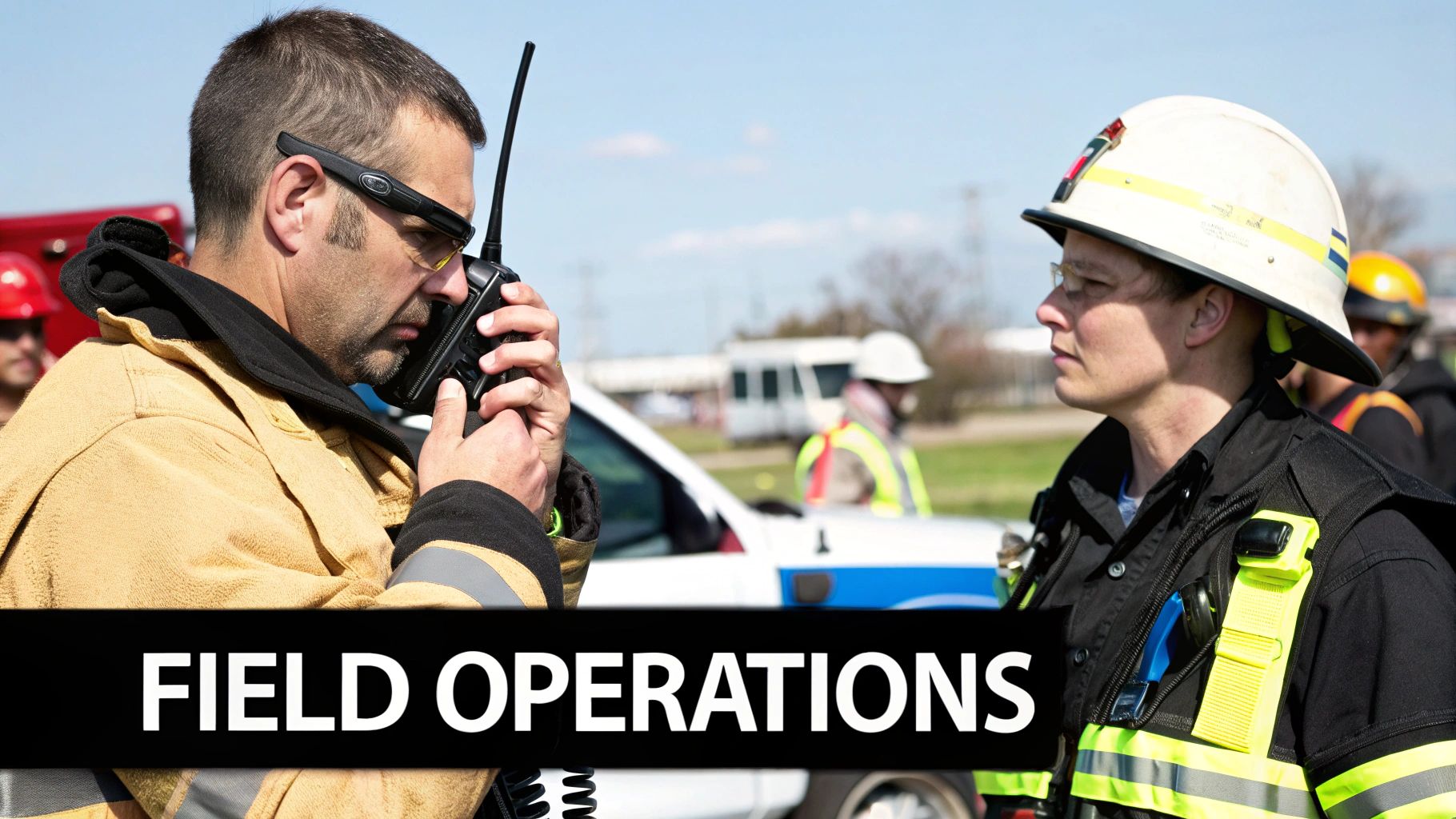
It’s easy to get lost in a list of technical specs. But what does a feature like ‘AI noise cancellation’ or ‘Lone Worker mode’ actually mean for your team on the ground? Let's move beyond the spec sheets and talk about how Hytera’s technology solves the real challenges Kiwi businesses face every day.
These features aren't just clever add-ons. They're direct answers to common operational headaches, built to boost safety, sharpen efficiency, and give you a real return on your investment. From a noisy Auckland construction site to an isolated South Island forestry block, specific Hytera radio features are making a powerful difference.
Enhancing Safety in High-Risk Environments
For any Kiwi business with staff in hazardous or remote conditions, safety is everything. A two-way radio is a lifeline, but advanced digital features transform it into a proactive safety tool. This is where features designed to protect your people really shine.
Picture a forestry worker operating machinery deep in a forest, miles from cell reception. It’s a high-risk situation where an accident could go unnoticed for hours. Hytera's safety features are built for this exact scenario.
- Lone Worker: Think of this as an automated check-in. The radio prompts the user to press a button at regular, pre-set intervals. If they don’t respond, the radio automatically sends an alert to base or other team members, flagging that something could be wrong.
- Man Down: This uses a built-in sensor to detect if the radio—and by extension, the user—has tilted past a certain angle or been still for too long, which could mean a slip or fall. It automatically triggers an emergency alarm, providing a crucial safety net for staff who might be unable to call for help themselves.
These aren't just buzzwords. For industries like forestry, agriculture, and infrastructure maintenance, these automated alerts are a core part of a robust health and safety plan. They offer peace of mind and enable a much faster emergency response when every second counts.
Crystal-Clear Audio When It Matters Most
Clear communication is non-negotiable. A garbled instruction on a busy construction site or in a loud packhouse can lead to costly mistakes, wasted materials, or even serious accidents. It’s a common problem that older analogue radios just couldn't solve well.
Hytera's professional DMR radios tackle this head-on with advanced AI-based noise cancellation. This smart tech actively identifies and filters out persistent background noise—the roar of a diesel engine, the whine of a saw, the clatter of machinery—so only the user's voice gets through. The result is stunningly clear audio, making sure instructions are heard and understood the first time, every time.
For a logistics company coordinating trucks at a busy port or a roading crew working beside live traffic, this level of clarity is a genuine game-changer for both efficiency and safety.
Streamlining Operations with Integrated GPS
Managing a fleet of vehicles or a team spread across a wide area is a massive logistical challenge. Where is everyone? Who is closest to the next job? How can you prove delivery times or that your team was on site?
Many professional Hytera radios available in New Zealand solve this with built-in GPS tracking. This feature sends the radio's location data back to a central dispatcher, giving you a real-time view of your entire team on a single map. If you'd like to dig deeper into this, our article on the Hytera VHF digital radio with GPS is a great place to start.
This capability is a huge advantage for a number of New Zealand industries:
- Transport & Logistics: Dispatchers can see their entire fleet, assign the nearest driver to a pickup, and give customers accurate ETAs.
- Security: A security firm can track guards on patrol, ensuring all checkpoints are covered and dispatching the closest officer to respond to incidents rapidly.
- Large Events: Event managers can see the location of all staff, from medical teams to security, ensuring everyone is positioned strategically for swift coordination.
Hytera has been a key global player in developing the digital protocols like DMR that make these features possible. Their leadership in technology is a big reason why their radios offer such powerful, integrated solutions that meet the complex communication needs across New Zealand.
Getting Your Hytera Radios Set Up for Success
Unpacking your new Hytera radios is a great feeling, but what you do next is what really counts. A bit of initial setup and some simple, ongoing care will ensure they perform reliably for years. Following a few key practices from day one will maximise their performance, extend their lifespan, and keep your team operating legally and effectively.
One of the first, and most often skipped, steps is proper battery conditioning. New lithium-ion batteries need to be fully charged before their first use. This simple action helps calibrate the battery's internal sensors, giving you more accurate battery life readings and getting the longest possible service life from each power pack.
Professional Programming Isn't Optional
While you can use licence-free radios straight out of the box, professional-grade Hytera radios are a different story. They need expert programming to be legally compliant and operationally useful here in New Zealand. This isn't just a "nice-to-have" — it’s a non-negotiable step for using private licensed frequencies.
A qualified technician will program your specific RSM-licensed frequencies into each radio, set up dedicated talk groups for different teams, and enable critical safety features like Lone Worker or Man Down alerts. Trying to do this yourself without the right expertise risks causing serious interference with other users, including emergency services, and can lead to hefty fines.
Think of professional programming as laying the foundation for your entire communication system. It ensures every radio "speaks the same language" on your private channels, is tailored precisely to your workflow, and ultimately turns a powerful device into a genuinely effective comms solution.
Building Good Maintenance Habits
You don't need to be a technician to protect your investment. Simple maintenance habits are the best defence against the common issues that can take a radio out of service. A little care goes a long way.
- Antenna Care: The antenna is your radio’s lifeline for clear transmission and reception. Regularly check that it's screwed on securely and look for any cracks or damage. A dodgy antenna will kill your radio's range and should be replaced immediately.
- Routine Cleaning: Kiwi work sites can be dusty and damp. Use a soft, dry cloth to wipe down the radio body, paying close attention to the speaker grille, mic port, and accessory connectors to keep them free of gunk.
- Charging Discipline: Try to avoid leaving radios on the charger indefinitely after they're full. Modern multi-bay chargers are smart, but it's good practice to pull a fully charged radio off to make room for others. This keeps your entire fleet ready for the next shift.
The Right Accessories Make All the Difference
A standard Hytera radio is incredibly capable on its own, but the right accessories transform it into a specialised tool. Whether you're a hospitality team needing discreet comms or a construction crew needing rugged gear, the right add-ons are absolute game-changers.
Consider these essentials commonly used in New Zealand:
- Speaker Microphones: These let you talk and listen without unclipping the radio from your belt. For anyone who needs to keep their hands free—think construction, security, and logistics—they're a must-have.
- Discreet Earpieces: Perfect for customer-facing roles in hotels or retail, these earpieces allow staff to get instructions without disturbing guests, keeping things professional.
- Multi-Unit Chargers: If you're running more than a handful of radios, a multi-unit charger is essential. It gives you a central, organised charging hub that ensures every radio is charged up and accounted for at the start of the day.
Investing in these tools doesn't just improve workflow; it directly boosts efficiency and safety. This reflects a bigger trend in the industry. The global Land Mobile Radio market, valued at USD 30.65 billion in 2023, is set to grow as companies in New Zealand and worldwide continue to depend on these tough communication systems. As a key player, Hytera's commitment to innovation puts them in a great position to meet this demand. You can get more details on these market dynamics and their projected growth.
Common Questions About Hytera Radios in NZ
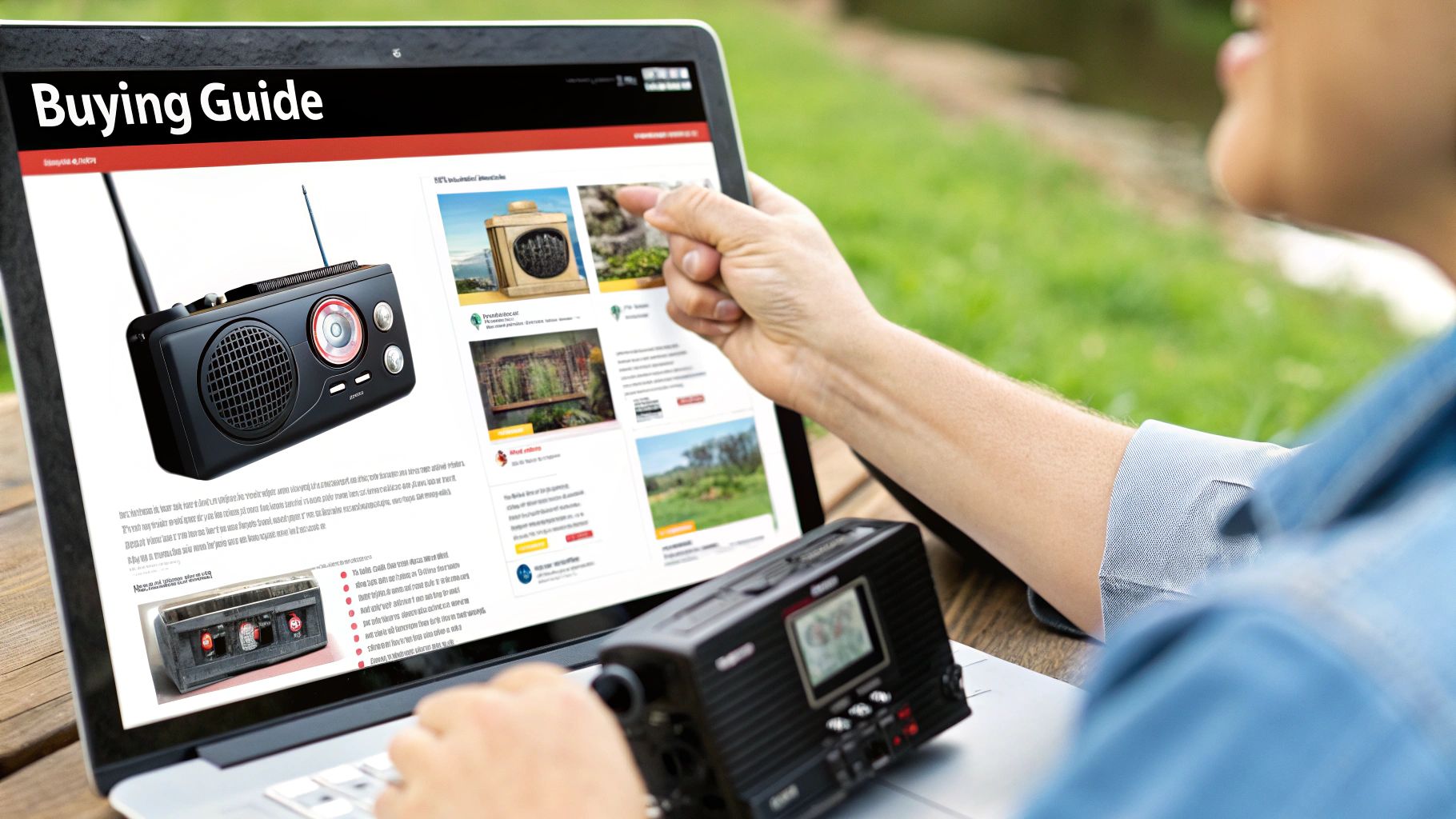
It's only natural to have a few questions when you're looking to invest in new comms gear for your team. To help you feel confident in your choice, we’ve put together answers to some of the most common queries we get from Kiwi businesses about Hytera radios. These are the practical, on-the-ground questions that often come up.
Do I Need a Licence for My Hytera Radio in New Zealand?
This is usually the first question people ask, and it’s a crucial one. The answer depends entirely on the specific radio model and how you intend to use it.
Some lower-power Hytera models are designed specifically to operate on New Zealand's General User Radio Licence (GURL) frequencies. This means you can use them legally straight out of the box without applying for a personal licence, which is perfect for simple, short-range communication.
However, for the superior range, security, and clarity of professional-grade Hytera radios, you absolutely need a private radio licence. This is managed through Radio Spectrum Management (RSM). Obtaining your own licensed frequency gives you an exclusive, interference-free channel for your team’s critical communications, which is a legal requirement for this type of use.
What Does an IP Rating Like IP67 Actually Mean?
You’ll spot IP ratings on all sorts of rugged gear, and it’s a really important measure of how tough a device is. The "IP" stands for Ingress Protection, and it tells you exactly how well-sealed a radio is against dust and water.
Let’s break down a rating like IP67:
- The first number, the 6, means the radio is completely dust-tight. No grit, grime, or sawdust can get inside, making it ideal for dusty environments like workshops, farms, or construction sites.
- The second number, the 7, tells you it's protected from being submerged in water up to 1 metre deep for 30 minutes.
Given New Zealand’s famously unpredictable weather and tough working conditions, a high IP rating like this isn't just a nice-to-have feature—it’s peace of mind that your gear will last.
A key takeaway is that many modern Hytera digital radios can operate in "mixed mode." This allows them to communicate seamlessly with both new digital (DMR) radios and your older analogue fleet, enabling a cost-effective, gradual upgrade to a fully digital system.
One final piece of advice: always buy your Hytera radios from an authorised dealer here in New Zealand. They don't just sell you the hardware; they provide the essential professional programming to make sure your radios are set up correctly, legally compliant, and perfectly tailored to how your team works.
Ready to equip your team with reliable, clear, and durable communication solutions? The experts at Mobile Systems Limited can help you select, license, and program the perfect Hytera radios for your New Zealand business. Explore our range and get in touch today at https://mobilesystems.nz.


